
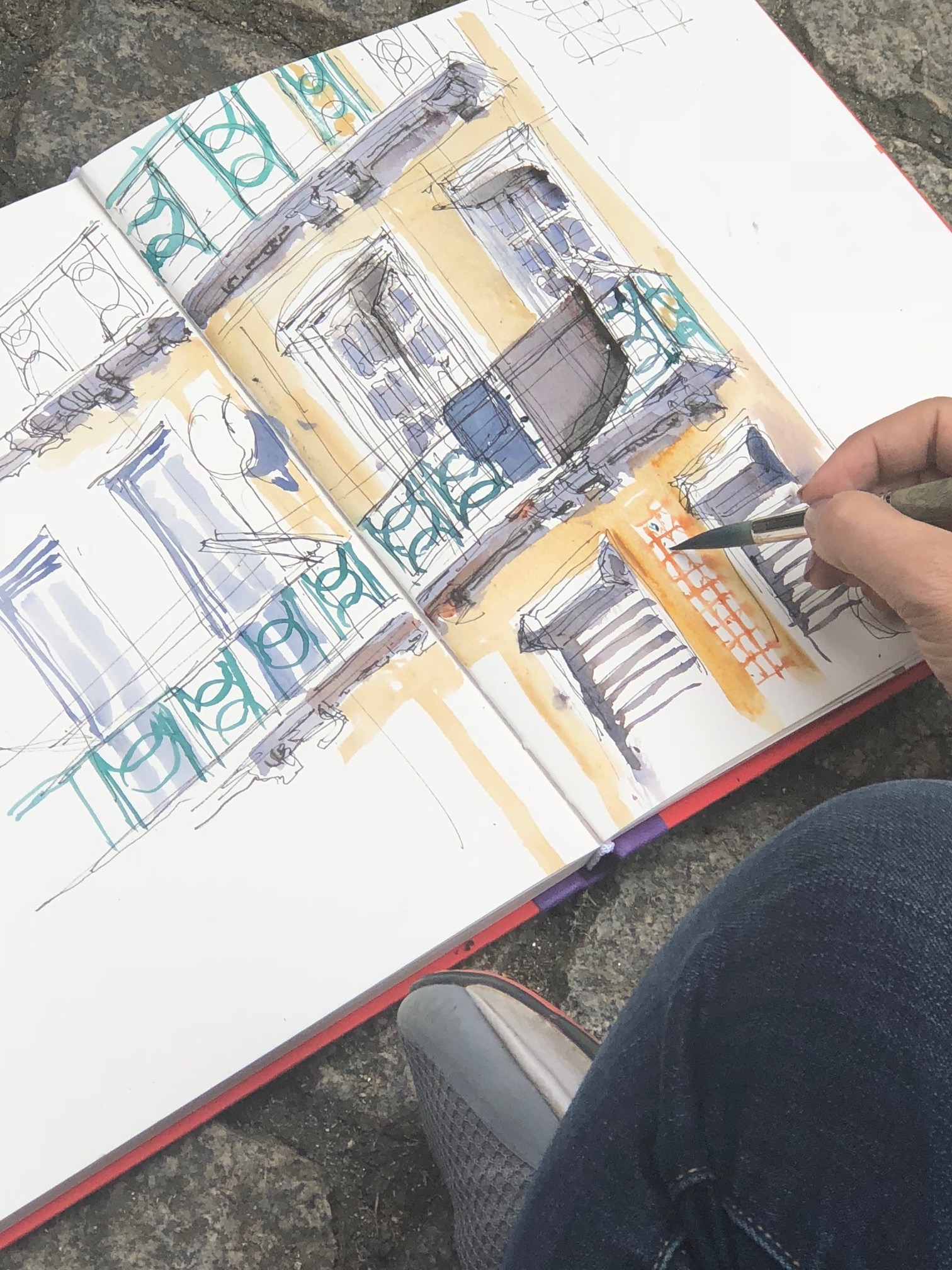
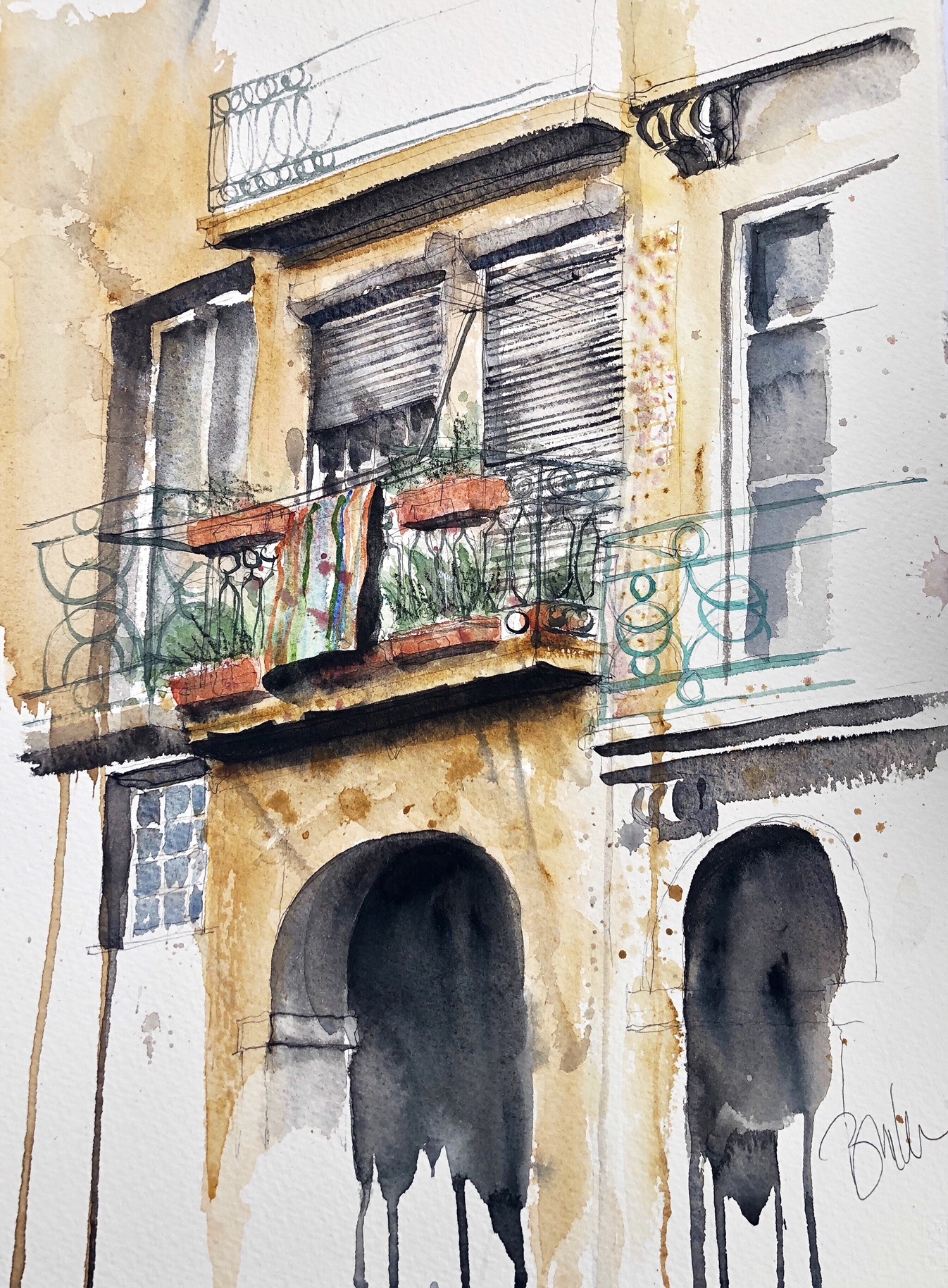
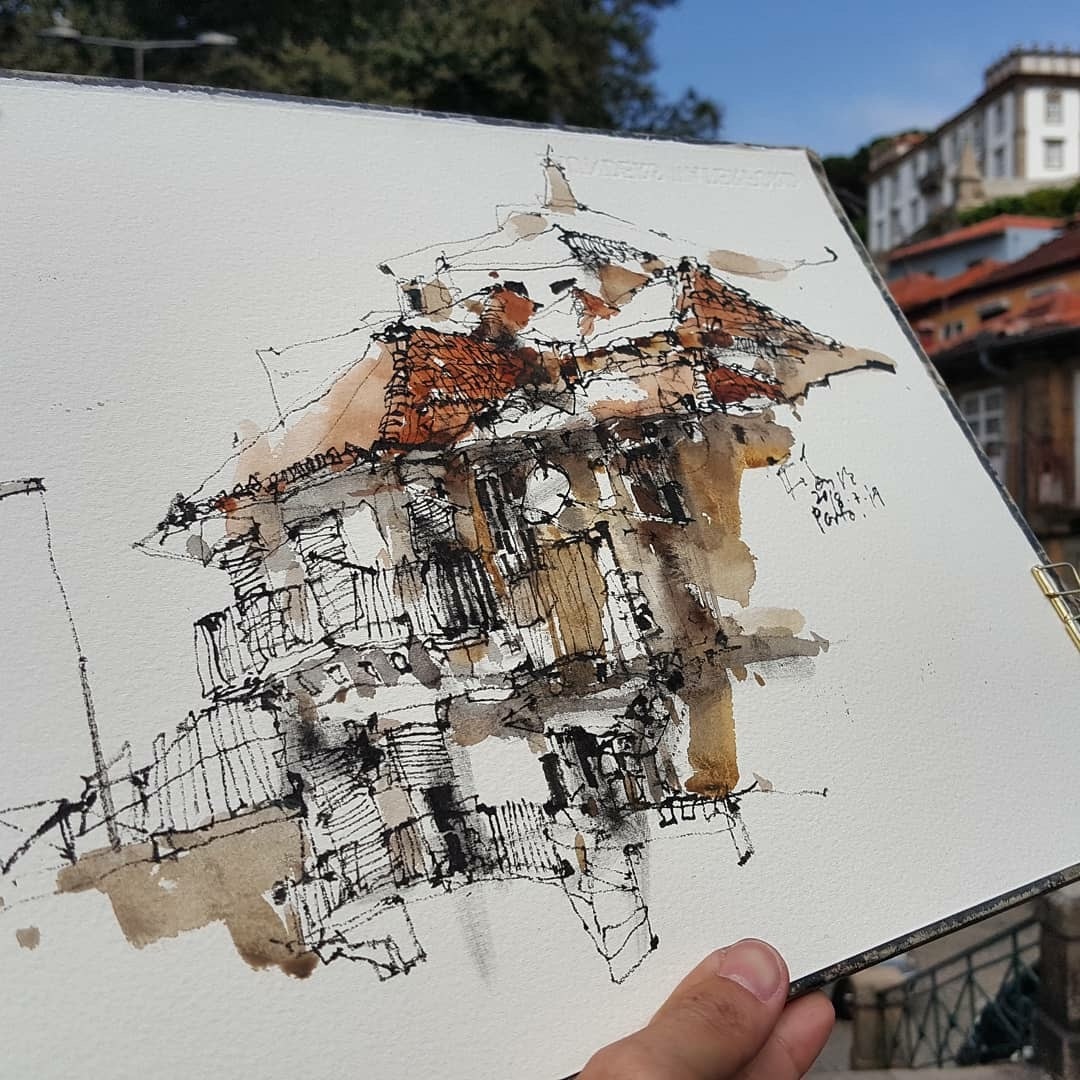
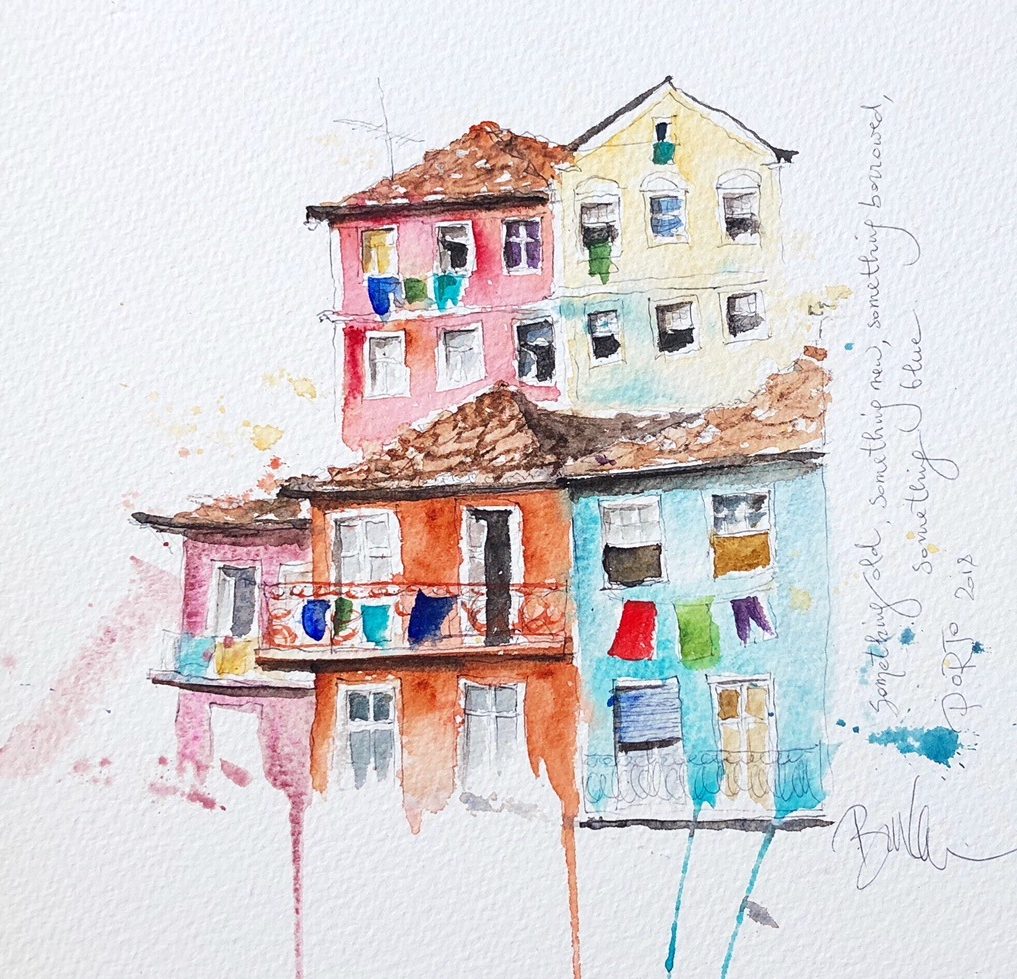

Hi everybody !
I hope you have a great summer and that your inner artist is having a great time as well!
I’m fully boosted from the Urbansketchers symposium in Porto in july! I had 4 great workshops from which I want to share some “takeaways”.
To warm up, I started with Reham Ali’s workshop. It was a wonderful experience: She makes great sketches with ink en watercolor, with really strong shadows. First she showed us how to build your drawing by drawing first all the vertical lines. This was very helpful. I felt a lot of resistance by doing this, but finally it helped to build my drawing more or less correctly. She was drawing everything immediately in ink, and didn’t mind the mistakes. She just continues drawing over them and thus including them in her art work.
Mistakes are your babies: you should LOVE them!
A remark about the subject: chose something with life in it, even with some ugliness: a balcony full of laundry and clutter. Clutter means human activity and is more interesting then something neat and beautiful. When the drawing is finished she starts the watercolour by first painting the shadows. The shadows give life to your painting. After that you can paint the rest. And also important: don’t forget to add big splashes with a big brush with natural hair. Don’t use a synthetic brush if you want beautiful natural splashes 
After that I had a wonderful workshop with Fred Lynch, who’s an illustrator and explained to us different ways of thinking and sketching like an illustrator. That was an eye opener for me, because often when I choose to draw something, I don’t immediately think about what I want to say. Instead I think “will this make a beautiful drawing?” Fred told us that illustrating is “writing with pictures”, and that if you think about what you want to say, of course your drawing will be more interesting. What’s the purpose of your drawing? Here are some tips:
- Focus on specificity and believability: look closely, pay attention to details, gesture, movement and mood.
- Aim to create a drawing that exhibits originality, one that shows your view and opinion. there are many ways to draw well. What’s yours?
- Interest: try to create an expression of your enthusiasm for the subject. Great drawings show evidence of insight as much as sight
- Aim for qualities of freshness, liveliness and humanity: drawings are created by humans and not by machines, and are made from lines, marks, smudges and washes.
- Explore while drawing and aim to show something new. every drawing is a new drawing and a new experience.
- FOCUS: play up what’s important for you and down what’s not. You’re a translator and not a copier of what’s in front of you. Remember that you’re not a photographer. We don’t see everything when we look at something. We focus.
Simone Ridyard also gave an interesting workshop, making perspective look easy and giving interesting composition advice with the “rule of thirds”:
- It creates balance and interest: through hotspots!
- Adds more complexity to a sketch rather then just placing your foal point in the center.
- Creates a dynamic energy in the composition
- Gives your sketch a sense of depth
I also had another workshop with Ch’ng Kiah Kiean. He’s is a generous teacher. His specialty is sketching with dry twigs and Chinese ink. Here’s his website: https://kiahkiean.com/
First KK (Let’s call him KK, as it’s easier for Europeans to pronounce. He doesn’t mind 
Drawing with such unusual and new tools is the perfect creativity boost. The perfect way to get out of your comfort zone and train new drawing muscles and a whole new way of seeing and putting what you see to the paper. How do you look at the objects to draw? And how do you draw?
The most important change that happened to me was that I got rid of FEAR : fear of making a bad drawing, fear of judgment of others, fear of not being able to draw this or that, fear of missing out the important details, fear of making a fool of myself…
Let me share you some of his tips. First the tools: dry twigs. KK draws with Water Jasmine twigs, but really: you can pick out any twig and make a point to it to draw. I also tried bamboo twigs you can buy in art supply stores but those are quite hard. It’s better to take a twig of another tree. The point has to be long and fine. Then you put cotton gauze in a small bottle and pour ink on it. Take Chinese ink with resin. It’s water proof. The cotton gauze is needed so the point of the twig wouldn’t be dipped in liquid ink. It avoids dripping on the drawing paper. After the drawing of the lines KK uses a hard brush (like bristles to paint with oil) and a container with a dishwasher sponge with Chinese ink on it. The ink must feel 90% dry. You must be able to make dry brush strokes. After shadowing the drawing with ink we finish it with watercolour, so use nice watercolor paper: not too smooth, not too rough.
And most important: PLAY !
Are you playing enough? How does it feel for your creativity? When are you most free to play?
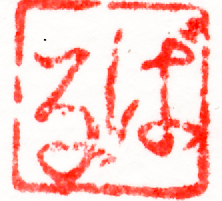
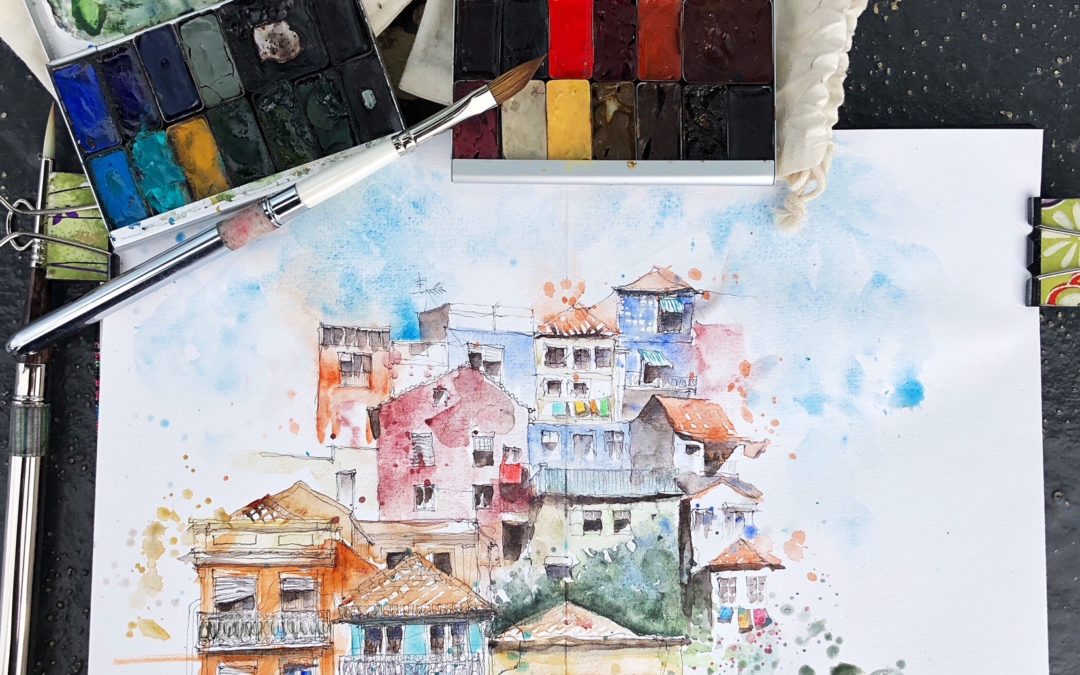
Merci pour ce petit comte rendu!
Merci beaucoup pour votre commentaire 🙂
Muito obrigado. Você é muito generosa repartindo conhecimentos
Thank you so much Barbara for sharing your workshops ‘ tricks and new tools. I am interested in KK’s approach. Would you be able to take a picture of the tools he provided – so as to see the size of the containers for the ink. As for the shadows, we’ll have to wait for the summer sun to come back. It is too wet right in the Southern Hemisphere. Cheers
Here it’s gotten wet as well in the meantime… Sure Agnes, I’ll send you a picture!
Love, Barbara
Yes be FEARLESS, it is paper and ink, not brain surgery….your art is your art, there are no “mistakes” or “corrections” needed, just keep going..
That’s right Eileen : it’s just paper and ink, not brain surgery! Excellent ! Thank you so much!
I did the workshop with Reham as well, and each time I make a mistake I tell my myself: no problem, it’s my baby 🙂
It’s a lovely expression, isn’t it? 🙂
Exactly : ” will this make a beautiful drawing?” I should get rid of this idea as well!
Tks for the takeaways!
you’re welcome 🙂
Thank you so much for sharing. I have always felt the need to make everything perfect; however, your dialogue has given me much needed insight. It has enabled me to connect the dots. Thank you so much!
Bedankt voor de namiddag in Oostende en de tips het is een aanzet om meer buiten te gaan schetsen. Ik zal het nu toch proberen.
Dank je wel ook de tips op je blog.
Veel dank aan jou Nicole voor de aanmoedigingen en je dankwoordje. Dat betekent veel voor mij 🙂
Veel tekenplezier!
barbara